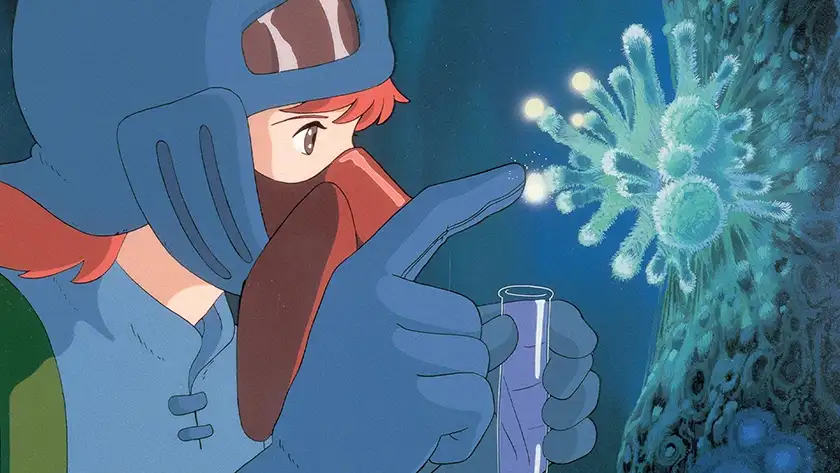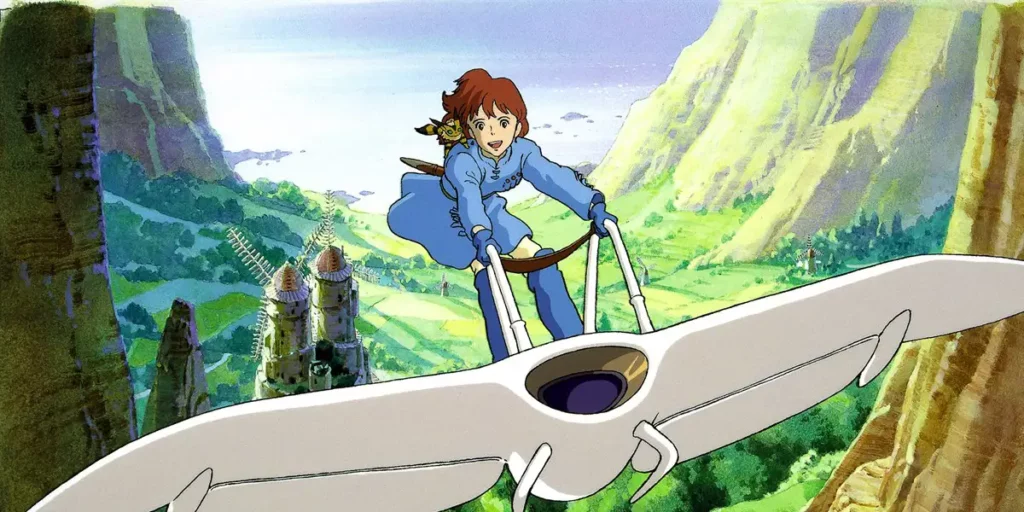Nausicaä is Miyazaki’s glorious second animation with an engaging narrative, strong lead character, spectacular visuals, and a touching environmental theme.
Director: Hayao Miyazaki
Genre: Animated, Sci-Fi, Adventure
Run Time: 117′
US Release: November 25, 1987
UK Release: June 12, 1987
Where to watch: on digital & VOD
Hayao Miyazaki once said that “the creation of a single world comes from a huge number of fragments and chaos”, and this statement perhaps applies best to only two of his films: The Boy and the Heron, and Nausicaä of the Valley of the Wind. The latter especially embodies the Japanese director’s complex ideas about humanity’s place in this world, and its relationship with its neighbours and nature.
More than in any other Studio Ghibli animation, in Nausicaä, Miyazaki seems to underscore the idea that no matter how complex a situation is or fragmented the world pieces are, there still exists that one unwavering spirit, a singular moral stance that shines through all the confusion. In Nausicaä, this force comes from our main heroine, Princess Nausicaä, whose desire to put things right and establish peace in the world is essentially that which we admire, associate with and are invested in seeing through. And, it was again Miyazaki who famously said that “what drives animation is the will of the characters. You don’t depict fate, you depict will.”
Based on Miyazaki’s own manga and partly inspired by such works as Lord of the Rings, Dune and Earthsea, Nausicaä thrusts us deep into one post-apocalyptic world from the very first scenes. It opens with an explorer surveying the devastation caused by the Toxic Jungle that had already pushed humans to the fringes of their habitat and threatens their survival. Next scenes will be our heroine, Princess Nausicaä of the Valley of the Wind, flying on her glider and then courageously exploring the Toxic Jungle. Together with her, we become passive explorers of this wondrous, but also deadly and polluted world with its fantastical vegetation and giant insects. Here, teal-green foliage hides fungi that release deadly spores, and, at any moment, a giant mutant insect called Ohmu may attack if it feels threatened.
Nausicaä is young, but she is already a skilful warrior and possesses deep knowledge of the surrounding fauna and flora, preparing to act as a mediator between this world and her own. Though quite deadly to her and her people, she does not view this forest and its dangerous insects as an enemy. Instead, she sees them as her neighbours to be understood and cooperated with to reach a mutual resolution of the situation. And, this theme of the importance of knowledge, and working with nature, and not against it, runs through the film.

We soon learn that Nausicaä’s home nation, the Valley of the Wind, is in the midst of a complex geopolitical situation, and somewhere not too far away, another kingdom, Tolmekia, has just invaded the Pejite nation. When a Tolmekian flying ship, which carries the kidnapped Princess of Pejite, crushes into the Valley, the Valley people realise that they cannot continue being mere passive observers of conflicts elsewhere. Soon, it comes the turn of the Valley of the Wind to experience an invasion. Meanwhile, both sides of the conflict have to deal with the approaching wrath of the giant insects of the Toxic Jungle. Can courageous Nausicaä, with her gift of understanding plants and insects, find the way to halt the threat coming from the Toxic Jungle, as well as stop the war?
Early on in Nausicaä, we may feel bombarded with many rapid political developments and arising threats, from the approach of giant insects to the possible awakening of a mythical giant warrior brought to the Valley by the Tolmekias. All this may confuse, but, even if filled with fantasy, these developments may simply reflect any real country’s often complex geo-political relations. And, despite the apparent narrative complexity, Miyazaki still manages to convey a clear vision.
His central character’s single-mindedness is apparent, and the fast-paced action often gives way to much quieter, dream-like visions of human warmth. For example, when Nausicaä befriends a little fox squirrel, or is being examined by an Ohmu and then transported to the sunlit state of her childhood. Accompanied by Joe Hisaishi’s wonderful score, it is these scenes that eventually reach the audience’s hearts and make Nausicaä such an entrancing viewing experience. The finale is one moving showdown where ruthless conquest goes head to head with compassion and love.
Nausicaä is Miyazaki’s only second major film, but it already displays many elements that would later form part of the director’s canon: a moral core, a meticulously crafted narrative, and visuals that pay attention to details. Our kind-hearted, independent heroine anticipates the arrival of Kiki from Kiki’s Delivery Service and Sophie from Howl’s Moving Castle; the film’s environmental stance would later appear in Princess Mononoke and Ponyo; and the elusive nature of evil can be seen in Spirited Away and The Boy and the Heron.
The latter is especially interesting since Miyazaki’s presentation of villainy is never straightforward or unreasonable. The Witch of the Waste (Howl’s Moving Castle), Kushana (Nausicaä) and Yubaba (Spirited Away) are antagonists, but their evil stems from their own self-interest, and they all either befriended or rendered pathetic and weak by the story’s end. “With pure water and soil, the plants from the Sea of Decay are not poisonous”, says Nausicaä at one point in the story. The idea may be that if the root of supposed “evil” is eliminated, the situation can turn to goodness. The evil represents a reaction to some wrong already done or a mere expression of self-interest/greed gone haywire.
Nausicaä of the Valley of the Wind boasts colourfully splendid visuals, especially for the year 1984, and, in no way its slightly convoluted plot lessens its overall emotional impact or significance. The strength of its main character and the sheer beauty of its narrative and thematic designs, full of benign undertones, remain Miyazaki’s very own. They proudly form part and parcel of his legacy, and an important part of it because the animation also paved the way for the creation of Studio Ghibli. Beautifully revealing one complex world, Nausicaä is a wondrous, adventure-filled animation with a benevolent core.
Nausicaä of the Valley of the Wind is now available to watch on digital and on demand, and on Blu-Ray and DVD.

